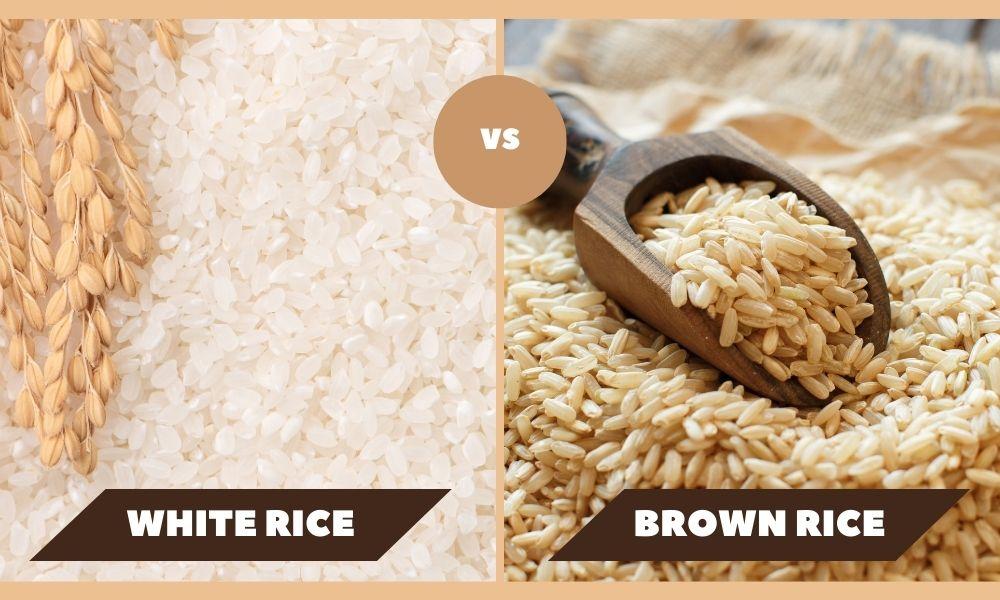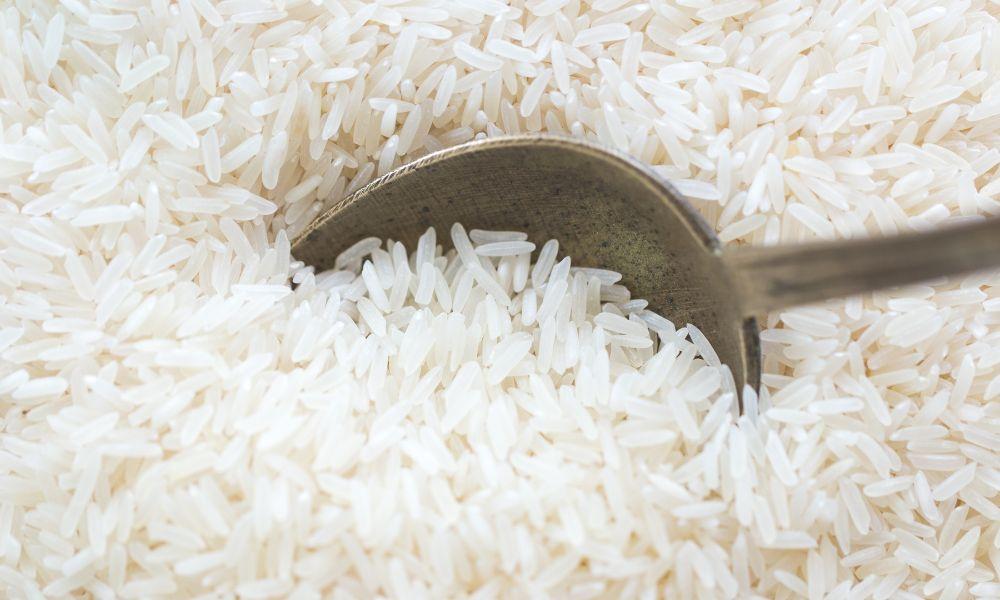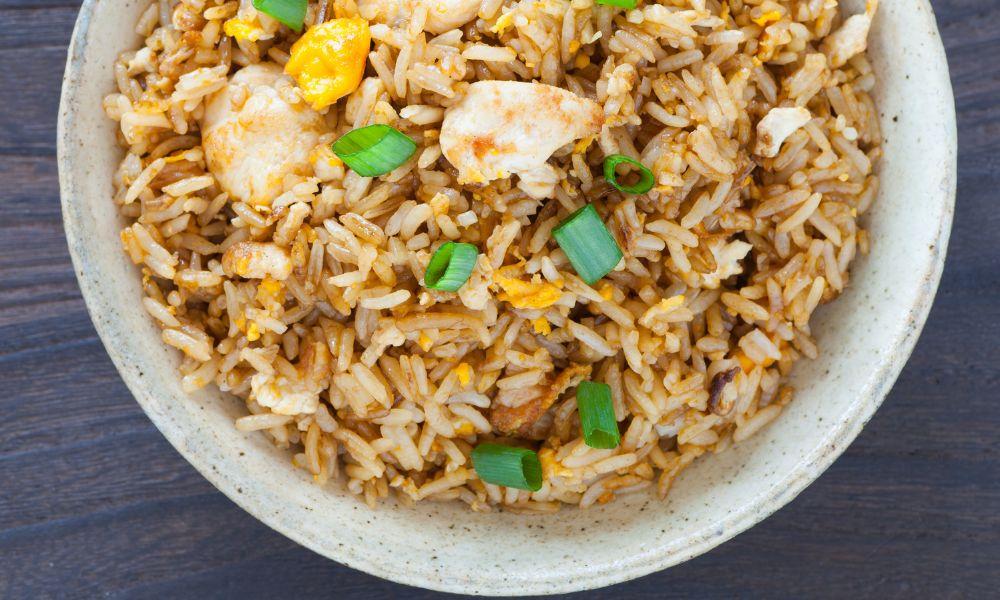Brown Rice vs. White Rice: Which is better? This blog post helps you choose based on taste, nutrition, and cooking time. Learn critical facts to pick the proper rice for your health and kitchen.
[su_box title=”🌾 Key Takeaway” style=”default” box_color=”#1383C8″ title_color=”#FFFFFF” radius=”3″]Brown rice is more nutrient-dense, offering more fiber, vitamins, and minerals than white rice. Its complex carbohydrates may help improve metabolic health and blood glucose levels.[/su_box]

Differences Between Brown and White Rice
Rice, a dietary staple for many cultures worldwide, comes in various forms. The most commonly known types are brown and white rice. These two varieties differ significantly in appearance, taste, and nutritional composition.
🍚 To start, the main distinction lies in their processing methods.
| Brown Rice | White Rice |
|---|---|
| Whole grain | Milled |
| Keeps bran, germ, endosperm | Loses bran and germ |
This process gives white rice its polished appearance but removes much of its nutritional value.
🍚 Another noticeable difference is the cooking time.
- Brown Rice: Requires more water and longer cooking time.
- White Rice: Requires less water and cooks faster.
However, this extra effort is worth it since brown rice provides numerous health benefits.
🍚 Picture this: You’re serving dinner at your table, and white and brown rice options are available.
- White Rice: Fluffy and light.
- Brown Rice: Denser with a nutty aroma and richer flavor.
🍚 Beyond their appearances, these two types of rice have distinct nutritional profiles that impact our overall health. Let’s dive into the details.
| Nutrient | Brown Rice | White Rice |
|---|---|---|
| Fiber | Higher | Lower |
| Vitamins | More | Fewer |
Brown rice and white rice differ significantly in processing methods, cooking time, appearance, taste, and nutritional composition. While white rice is a polished version that has lost most of its nutritional value, brown rice is a whole grain with numerous health benefits. When serving or consuming rice, it’s essential to consider these differences to make informed dietary choices.
Nutritional Profiles: White and Brown Rice
| Aspect | White Rice | Brown Rice |
|---|---|---|
| B Vitamins | Thiamin (B1), Niacin (B3), Folate (B9) | Thiamin (B1), Riboflavin (B2), Niacin (B3), Vitamin B6, Pantothenic Acid (B5), Folate (B9) |
| Iron | Present but in smaller amounts | Higher amounts vital for oxygen transport |
| Fortification | Available in some regions with added folic acid and iron | Generally not fortified |
| Other Nutrients | Minimal amounts of Vitamin E, Selenium, Magnesium, Potassium | Contains Vitamin E, Selenium, Magnesium, Potassium |
| Fiber Content | Low | High, beneficial for digestion and heart health |
| Glycemic Index | High, can cause quick spikes in blood sugar | Lower, better for blood sugar control |
Nutritional Profiles: White and Brown Rice
While white and brown rice contains carbohydrates—an essential energy source—the differences lie in their fiber content, nutrient density, and impact on blood sugar levels.
🍚 Fiber Content
- Brown Rice: Takes center stage with higher fiber content, improving digestion and reducing the risk of heart disease.
- White Rice: Lacks in fiber.
🍚 Nutrient Density
- Brown Rice: Contains valuable amounts of vitamins B1, B3, B6, vitamin E, iron, and antioxidants called phytochemicals.
- White Rice: Provides some essential vitamins and minerals like folate and selenium.
🍚 Impact on Blood Sugar
- Brown Rice: Lower glycemic index, better for blood sugar control.
- White Rice: Higher glycemic index can cause blood sugar levels to spike.
Brown rice’s nutritional profile surpasses white rice’s due to its higher fiber content and nutrient density. It makes for a more wholesome choice that improves blood glucose levels, metabolic health, and overall wellness.
Now that we’ve explored the differences between brown and white rice and analyzed their nutritional profiles, we must consider how these factors influence our health choices. The next section will discuss the potential health benefits of including brown rice in your diet.
Vitamins and Minerals in Brown Rice

Brown rice is a nutritional powerhouse packed with essential vitamins and minerals that promote overall health and well-being. Unlike white rice, brown rice retains the nutrient-rich bran and germ layers, making it a whole grain. Let’s explore some of brown rice’s key vitamins and minerals.
🍚 B Vitamins
- General Role: Vital for energy production, metabolism, and brain health.
- Types in Brown Rice: Particularly rich in vitamin B6, but also contains thiamin (B1), riboflavin (B2), niacin (B3), pantothenic acid (B5), and folate (B9).
Niacin Highlight: Converts food into energy, supports nervous system health, and helps manage cholesterol.
🍚 Iron
- Role: Vital for oxygen transport and preventing iron-deficiency anemia.
🍚 Additional Vitamins and Minerals
- Vitamin E: An antioxidant that supports immune function and skin health.
- Selenium: Involved in DNA synthesis and acts as an antioxidant.
- Magnesium and Potassium: Needed for nerve function and healthy blood pressure.
While brown rice is packed with essential vitamins and minerals, let’s now delve into the nutrient profile of white rice to better understand its unique characteristics.
Vitamins and Minerals in White Rice

White rice, unlike brown rice, undergoes a refining process that removes the bran and germ layers. This process affects the vitamin and mineral content, making white rice less nutrient-dense than its brown counterpart. However, it still has some nutritional value.
🍚 B Vitamins
- White rice contains B vitamins such as thiamin (B1), niacin (B3), and folate (B9).
- While these amounts might be lower than those found in brown rice, they still contribute to overall health.
- Thiamin plays a crucial role in energy metabolism, niacin supports nervous system function, and folate is essential for DNA synthesis and cell growth.
🍚 Iron
- Additionally, white rice provides iron, although in smaller amounts compared to brown rice.
- Iron remains vital for oxygen transport in the body and prevents iron-deficiency anemia.
📝 Fortified White Rice
- It’s important to note that fortified white rice is also available in some regions.
- Fortified white rice has certain nutrients like folic acid and iron added back after processing, increasing its nutritional value.
🍚 Other Nutrients
- When it comes to other vitamins and minerals, white rice falls short compared to brown rice.
- It contains minimal amounts of vitamin E, selenium, magnesium, and potassium.
Therefore, if you’re seeking these specific nutrients in your diet, incorporating other sources like fruits, vegetables, nuts, or whole grains would be beneficial.
Health Benefits and Downsides

When it comes to the debate between brown rice and white rice, understanding the health benefits and downsides is crucial in making an informed choice. Both varieties have unique characteristics, nutritional profiles, and implications for our overall health.
Let’s start with the benefits of brown rice. One of the significant advantages is its higher nutrient density compared to white rice. Brown rice contains the bran, germ, and endosperm layers intact, making it a whole grain packed with essential vitamins, minerals, and fiber. This combination contributes to improved blood glucose levels and metabolic health. Additionally, studies suggest that replacing white rice with brown rice in our diet may reduce the risk of developing type 2 diabetes.
On the other hand, white rice may be more suitable for those with digestive issues or sensitive stomachs due to its refined nature. The bran and germ layers are removed during processing, resulting in a smooth texture that is easier to digest for some individuals. However, it’s important to note that white rice falls under the category of simple carbohydrates due to its stripped-down nature. This means it can cause blood sugar spikes more rapidly than complex carbohydrates like brown rice.
Aside from these considerations, there are additional factors worth mentioning. Brown rice contains higher levels of B vitamins, vitamin E, iron, and phytochemicals compared to white rice. These nutrients play vital roles in promoting overall health and well-being.
Comparison Table: Brown Rice vs White Rice
| Health Aspect | Brown Rice | White Rice |
|---|---|---|
| Nutrient Content | Higher in fiber, vitamins, and minerals | Lower in fiber and nutrients |
| Energy and Blood Sugar | Stabilizes blood sugar, provides sustained energy | A quick source of energy, it can cause blood sugar spikes |
| Type 2 Diabetes Risk | Lower risk due to complex carbohydrates | Higher risk due to impact on insulin response |
| Digestive Health | Aids in bowel movements, prevents constipation, | Easier to digest, suitable for sensitive stomachs |
| Weight Management | Increases satiety, aids in weight control | Quick energy but can leave you feeling hungry soon |
| Cultural Relevance | Gaining popularity blends well in health-conscious diets | Versatile, blends well in various traditional dishes |
| Research Findings | Linked to lower diabetes risk, higher nutrient content | Linked to higher diabetes risk, lower nutrient content |
Now that we’ve explored the health benefits and downsides let’s dive deeper into the specific health implications of consuming brown rice.
Health Implications of Consuming Brown Rice
Brown rice’s nutrient profile and slower digestion make it beneficial for several aspects of our health.
🍚 Digestive Health
- The high fiber content aids in maintaining regular bowel movements, promoting digestive health, and preventing constipation.
🍚 Blood Sugar and Energy
- This slow digestion also leads to a gradual release of glucose into the bloodstream, which helps stabilize blood sugar levels and provides sustained energy throughout the day.
🍚 Weight Management
- Moreover, studies have shown that the consumption of brown rice may have a positive effect on weight management and reduced risk of obesity.
🍚 Type 2 Diabetes
- The complex carbohydrates present in brown rice can help regulate insulin levels and reduce the likelihood of insulin resistance, a key factor in the development of type 2 diabetes.
🍚 Vitamins and Minerals
- The abundance of B vitamins in brown rice plays a vital role in energy production, brain function, and overall cellular health.
- Vitamin E is an antioxidant, protecting cells from damage caused by free radicals.
- Furthermore, iron is vital for maintaining healthy red blood cells and preventing iron-deficiency anemia.
📝 Individual Considerations
- It’s essential to note that while brown rice offers these valuable health benefits, there are always individual considerations that come into play. Factors such as personal dietary needs, preferences, cultural influences, and food accessibility all play roles in determining what is best for each person.
Health Implications of Consuming White Rice
Regarding the health implications of consuming white rice, it’s crucial to recognize that it’s a refined grain. During its processing, the outer bran and germ layers are removed, resulting in a loss of key nutrients and fiber. As such, white rice is lower in fiber content compared to its brown counterpart.
🍚 Energy Source
- While white rice can serve as a quick energy source, especially for athletes or those needing a rapid glucose boost, its high glycemic index can cause blood sugar spikes.
🍚 Blood Sugar and Hunger
- The rapid increase in blood sugar levels, followed by a sharp drop, can leave you feeling hungry again soon after eating.
🍚 Type 2 Diabetes Risk
- Studies have linked regular consumption of white rice to an increased risk of type 2 diabetes due to its impact on insulin response.
🍚 Digestive Benefits
- For individuals with digestive issues or sensitive stomachs, white rice can be gentler on the gut and easier to digest.
🍚 Cultural Relevance
- White rice is a versatile ingredient that blends well with various dishes from different cultures worldwide.
📚 Research Highlights
- According to USDA data, brown rice contains almost five times the fiber content of white rice.
- Studies in the International Journal of Food Sciences and Nutrition reported that replacing white rice with brown can lower blood sugar levels and decrease the risk of type 2 diabetes by 16%.
- Research by the American Journal of Clinical Nutrition shows that brown rice has approximately 80% more manganese than white rice.
Cooking White Rice vs Brown Rice: Time and Methods

Now, let’s explore the differences between cooking white and brown rice. One major distinction is the cooking time required for each variety.
Comparison Table: Cooking White Rice vs. Brown Rice
| Aspect | White Rice | Brown Rice |
|---|---|---|
| Cooking Time | 15-20 minutes | 35-40 minutes |
| Method Variations | Stovetop varies for Basmati or Jasmine rice | Stovetop |
| Water Ratio | 1:2 (one cup of rice to two cups of water) | 1:2.5 or 1:3, depending on the desired tenderness |
| Appliance Convenience | Electric rice cookers and instant pots are available | Electric rice cookers and instant pots are available |
The methods for cooking white and brown rice are similar, with the main difference being the proportions of water used.
It’s worth mentioning that technological advancements have led to the availability of electric rice cookers and instant pot recipes, making cooking both white and brown rice a breeze. These appliances provide consistent results and can save you time in the kitchen.
Imagine cooking rice as if nurturing a plant. White rice might be comparable to growing cacti – it needs less water (cooking time) due to its low fiber content, whereas brown rice is akin to cultivating delicate flowers, requiring more attention and care.
FAQs
How do the taste and texture of brown rice compare to white rice?
Brown rice has a nutty and slightly sweet taste, along with a chewier texture compared to white rice’s softer and milder flavor. The differences in taste and texture can be attributed to brown rice’s outer bran layer and germ, which contains more fiber, nutrients, and beneficial compounds such as antioxidants. However, it’s worth noting that individual preferences may vary.
In what dishes or cuisines is one type of rice preferred?
In Asian cuisines such as Chinese, Japanese, and Thai, white rice is commonly preferred due to its fluffy texture and neutral flavor, making it a versatile accompaniment to a wide range of dishes including stir-fries, curries, and sushi. On the other hand, brown rice is often favored in healthier or whole-food-centric cuisines where its nutty flavor and higher fiber content are valued. Additionally, studies have shown that consuming brown rice instead of white rice may decrease the risk of developing type 2 diabetes.
What is the process for milling white rice to make it different from brown rice?
Milling white rice involves removing the grain’s outer layers, including the bran and germ. This results in a polished appearance and a longer shelf life than brown rice. However, this refining process removes essential nutrients, such as dietary fiber, vitamins, and minerals. According to studies, brown rice has significantly higher levels of nutrients like magnesium, zinc, and vitamin B6 than white rice. So, while white rice may have a finer texture and prolonged storage quality, it lacks the nutritional benefits that make brown rice a healthier choice.
What nutritional benefits does brown rice offer that white rice does not?
Brown rice offers several nutritional benefits that white rice lacks. Firstly, brown rice retains its bran and germ layers during processing, containing fiber, vitamins (such as B and E), minerals (such as magnesium and phosphorus), and antioxidants. In contrast, white rice removes these layers, resulting in a loss of these vital nutrients. Additionally, brown rice has a lower glycemic index than white rice, leading to slower digestion and steadier blood sugar levels. A study published in the Archives of Internal Medicine found that higher consumption of white rice is associated with an increased risk of type 2 diabetes, further highlighting the importance of choosing brown rice for its nutritional benefits.
Are there any cultural or historical differences in the use of brown and white rice?
Yes, there are significant cultural and historical differences in brown and white rice use. Brown rice has a long-standing tradition in Asian cultures, particularly in countries like China and Japan, where it has been consumed for centuries. Its nutty flavor and chewy texture have been valued in traditional dishes like sushi and fried rice. On the other hand, white rice gained popularity during industrialization as it was believed to have a longer shelf life. It became a staple in Western cuisines and was embraced by many cultures due to its softer texture. Despite the rise in global health consciousness, the cultural association with brown rice remains strong in Asia, while white rice is still preferred in many Western countries. Statistics show that brown rice consumption is significantly higher in Asian nations than in Western countries, with Japan having the world’s highest per capita consumption of brown rice.
(Source: Statista)






